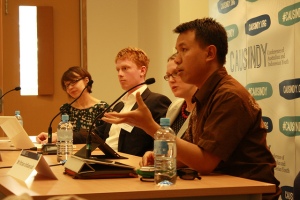Fitrian Ardiansyah , The Jakarta Post, Climate Solutions Column, Jakarta | Tue, 01/19/2010 11:18 AM | Environment
Stopping and reversing the loss and degradation of forests and peat land is a crucial element of any climate solution developed in Indonesia.
Last year, in his pledge to reduce greenhouse gas (GHG) emissions and in his Cabinet’s “100 days” program, President Susilo Bambang Yudhoyono stated that Indonesia would tackle emissions from deforestation and changes in land use, including from forest and land fires.
This year, the minister of forestry vowed to add an extra 21.15 million hectares of forest by 2020 (500,000 hectares per year) as the top priority to contribute to the President’s pledge.
While this is a good move, it may not provide sufficient results to reduce the country’s GHG emissions.
Various reports have concluded that the deforestation rate in this country still outweighs that of reforestation — the annual rate of deforestation stands at 0.8 to 1.09 million hectares compared to 0.3 to 0.6 million hectares for reforestation (re-planting).
Most GHG emissions in this sector usually come from forests being converted to expand the forestry industry (e.g. logging, pulp wood plantation) and agriculture (e.g. oil palm plantation), build infrastructure, settlements and set up mining operations; illegal and destructive logging outside and inside legal forest concessions; and forest and land fires to clear space for agricultural lands.
Addressing these, hence, is key to reducing the country’s GHG emissions.
The million dollar question that needs to be answered now is: “What sort of policies, incentives, investments and practices are required to retain the remaining forests and still allow for economic growth in Indonesia?”
At the policy level, it is essential for the government to start promoting, adopting and implementing sustainable and responsible spatial and land use development.
It is clear that one of the stumbling blocks to achieve the President’s pledge is that carbon issues are yet to be integrated into land-use planning in this country, while land-grabbing continues due to poor governance.
To be able to plan the use of land effectively, the work ought to be carried out at island, provincial and district levels, integrating both economic and ecosystem values for priority landscapes.
Having adopted a decentralized decision-making process, some initial steps have been carried out to demonstrate a good process in integrating sub-national and national levels of effective land use policies.
These include steps taken under the Sumatra Governors’ Declaration, in the Heart of Borneo and
in Papua.
In Sumatra, for example, four ministers and 10 provincial governors committed themselves to protect the remaining forests and critical ecosystems of this island by developing ecosystem-based spatial plans that will serve as the basis for future development on the island.
The Road Map for Saving Sumatra — expected to become a blueprint for conducting ecosystem-based spatial planning — was subsequently finalized and endorsed by those governors.
Nevertheless, concrete actions are required, especially in key sectors, if these policies are to succeed.
In the forestry sector, standing stock and performance of different forest areas should be assessed.
These assessments can then become the basis to decide how to manage the forests in a sustainable manner, while reducing emissions and enhancing carbon stocks.
In the natural production forests, for instance, reduced impact logging can be introduced to lower emissions and increase the carbon stock.
When it comes to the use of forest lands to produce palm oil, growth in demand could be met by improving yield on existing plantations by 1.5 to 2 percent per year, and particular focus needs to give to smallholders, or planting on abandoned land.
When agricultural development requires new land, various statistics have indicated that between seven and 14 million hectares of degraded, abandoned lands may be used.
To achieve this result, non-state actors — the private sector, NGOs and local communities — need to work together to promote policy reforms reconciling Indonesia’s land-use and sector’s policies.
These actors and the government will need incentives and assistance to sustain their work and achieve their goals.
The Copenhagen Accord reached last December recognizes the crucial role of reducing emissions from deforestation and forest degradation and enhancing the removal of GHG emissions by forests (REDD-plus).
Around US$30 billion has been set aside to help developing countries adapt to and mitigate the effects of climate change.
Other important actors need to be invited to join the cause: banks and other financial institutions.
In the past decade, billions of dollars were invested in sectors related to land use by both national and foreign investors.
These institutions play an indispensable role in supplying capital to commodity producing companies by providing loans or buying their shares.
There is a glimmer of hope. Several commercial banks have developed detailed forest, plantation
and mining policies over the past few years.
According to their policies, these banks strive to finance only companies that care for high conservation value forests, to minimize their environmental impact and respect the rights and needs of local communities.
The overall work combining policies, incentives and actions is critical to ensure fundamental changes in how Indonesia manages, protects and sustains its forests.
Today, this kind of changes must come from various actors who can eradicate unsustainable practices and hopefully take the pressure off forests and peatlands.
The writer is program director of climate & energy at WWF-Indonesia, and adjunct lecturer at Paramadina Graduate School of Diplomacy. He can be reached at fardiansyah@wwf.or.id
The original link: http://www.thejakartapost.com/news/2010/01/19/climate-solutions-innovative-ways-retaining-forests.html


